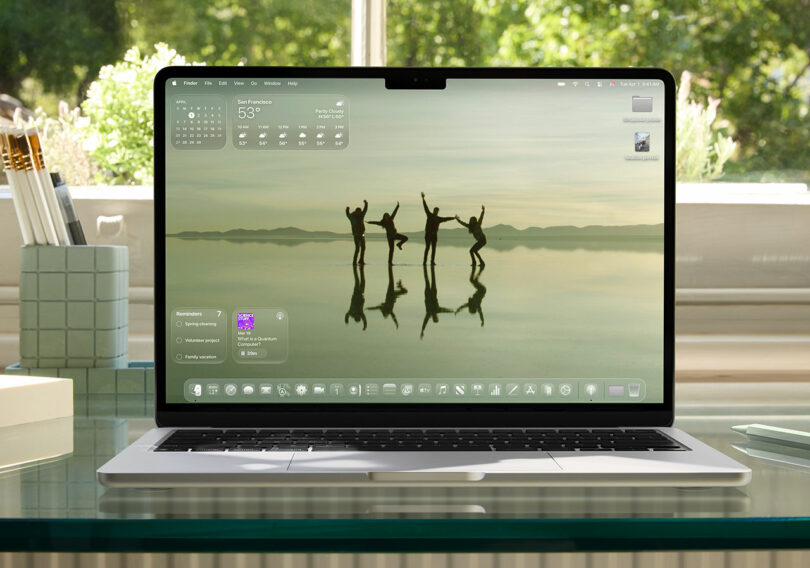After years of favoring minimalism and flat design, Apple is ushering in a new era of software aesthetics with a design language it’s calling Liquid Glass. Revealed at the 2025 Worldwide Developers Conference (WWDC), Liquid Glass marks Apple’s most sweeping visual overhaul in more than a decade – and signals a return to more layered, tactile interfaces across all major platforms.
Design Shift
Liquid Glass represents a pivot away from the ultra-flat visuals introduced with iOS 7 in 2013, which famously discarded skeuomorphism in favor of crisp geometry and minimal gradients. That shift, while modern at the time, drew mixed reviews for stripping Apple’s software of its texture and warmth.
Now, Apple is embracing a middle ground: a new aesthetic that brings depth and dimensionality without returning fully to faux-analog metaphors. While still unmistakably digital, the new design incorporates translucent, glass-like elements that mimic the way light reflects, refracts, and bends in real-world materials. The result is a more immersive, visually responsive interface – and one that Apple says better highlights content without overwhelming it.
What Is Liquid Glass?
Despite the name, Liquid Glass isn’t a physical material – it’s a dynamic, software-rendered visual effect. Think of it as a digital skin that sits atop user interface elements: a fluid, semi-transparent layer that shifts depending on content and context.
Apple says Liquid Glass has been engineered to behave like actual glass: its translucency adapts to light and dark environments, it responds to user interactions with lifelike reflections, and it creates specular highlights as users move through apps. Whether it’s a button, a control, or a widget, every element crafted in Liquid Glass appears to float, bend light, and subtly react to its surroundings.
Design That’s Truly Universal
For the first time in Apple’s history, a single design philosophy is rolling out simultaneously across all five major operating systems: iOS 26, iPadOS 26, macOS Tahoe 26, watchOS 26, and tvOS 26. While the core aesthetic remains consistent, each platform adapts Liquid Glass to fit its own use case.
On iOS and iPadOS, Liquid Glass enhances everything from app icons and tab bars to the Lock Screen clock, which now subtly tucks itself behind photo wallpaper subjects.
On macOS Tahoe, the Dock, app windows, and sidebars have all been reimagined. A fully transparent menu bar creates the illusion of even more screen real estate, while updated app interfaces – like Safari and Apple Music – lean into layered, refractive design.
On tvOS, Liquid Glass redefines the Control Center and playback controls, allowing users to see content behind menus and buttons.
On watchOS, complications and system UI benefit from the same depth and visual harmony, albeit in a much smaller format.
Apps That Morph and Flow
Apple’s attention to detail extends to how Liquid Glass behaves in motion. Tab bars now dynamically shrink and expand as you scroll, adapting fluidly to your interactions. Sidebars refract the content behind them, blending form and function in a way that always keeps your place in view.
In redesigned apps like Camera, Safari, and FaceTime, controls float above the content in semi-transparent layers, surfacing when needed and fading into the background when not. It’s a consistent design approach that Apple hopes will make navigation more intuitive while preserving the focus on content.
For Developers, Too
To ensure a consistent experience across apps, Apple has updated its development frameworks — SwiftUI, UIKit, and AppKit — with new APIs that support Liquid Glass materials and behaviors. That means third-party developers can adopt the look and feel of the new design without starting from scratch. Apple is positioning this not just as a visual refresh, but as a foundational shift that will shape future experiences across its ecosystem.
All five Liquid Glass-powered operating systems are currently available in beta and will be refined throughout the summer. The final versions are expected to launch publicly this fall, likely alongside new iPhone and Apple Watch hardware in September.
As with any visual overhaul, the real test will be how Liquid Glass feels in day-to-day use. While Apple’s demos showcase dazzling transitions and nuanced lighting effects, user feedback during the beta period may influence how broadly and heavily the new design is applied. Still, with Liquid Glass, Apple seems intent on restoring some of the whimsy and tactility that once defined its software – and doing so in a way that feels both modern and deeply integrated across devices.
For more information, visit apple.com.
All visuals courtesy of Apple.
